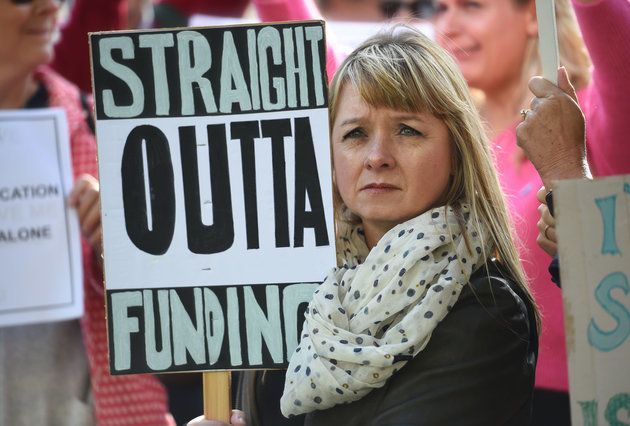
The Education Secretary wants to see a reduction in the number of exclusions after a root-and-branch review found “too much variation” in those being kicked out of school.
Damian Hinds said the government would begin implementing the 30 recommendations made by former Conservative minister Edward Timpson following his long-awaited report into school exclusions, published on Tuesday.
It includes making sure schools are accountable for exam results of pupils they exclude.
It also attempts to tackle off-rolling – the controversial practice of removing children from the school register without formal exclusion.
Hinds said: “We would like to see the level of exclusions come down.
“It is lower than it was 10 years ago, but it is better if children are not being excluded.”
The review highlights variation in exclusions practice across different schools, local authorities and certain groups of children.
It concludes that while there is no optimal number of exclusions, action needs to be taken to ensure permanent exclusions are only used as a “last resort”.
According to the analysis, 85% of mainstream schools did not expel a single pupil in 2016/17, but 0.2% expelled more than 10 pupils in the same academic year.
It also shows that 78% of permanent exclusions were issued to children who had special educational needs (SEN), or classified as in need or eligible for free school meals.
Certain ethnic groups, including Bangladeshi and Indian pupils, have lower rates of exclusion than White British pupils.
The analysis also found some ethnic groups, such as Black Caribbean and Mixed White and Black Caribbean pupils, experienced higher rates, after controlling for other factors.

Overall, 0.1% of the eight million children in schools in England were permanently excluded in 2016/17 – an average of 40 a day – and the highest figure since 2007/8 (0.11%). This represented a year-on-year rise since 2013/14.
Fixed-term exclusions, also known as suspensions, are also on the increase: up from 3.5% in 2013/14, to 3.88% the following year, 4.29% the year after and 4.76% the following year.
Earlier this year, London Mayor Sadiq Khan and eight police and crime commissioners wrote to the Prime Minister to warn that the “broken” system of support for troubled and excluded youngsters lay behind the recent rise in knife crime.
They said excluded children were “sucked into criminality” and were “at much greater risk of becoming either perpetrators or victims of serious youth violence”.
Geoff Barton, general secretary of the Association of School and College Leaders, said he was “disappointed” that funding was not “given anywhere near enough weight” in the review.
He added: “The current level of funding is so desperately inadequate that many schools have had to cut back on support staff who provide early intervention to children with challenging behaviour.
“This makes it more difficult to prevent challenging behaviour escalating to the point of exclusion, and we believe this has fuelled the rise in the rate of exclusions in recent years. Schools must have the funding they so clearly need.”

Paul Whiteman, general secretary of NAHT (National Association of Head Teachers), said exclusion was “not a standalone problem”.
He said: “Too often provision for pupils at risk of exclusion is regarded as a separate element of educational provision for a specific group of pupils, in the same way that special and specialist schools are frequently ‘set aside’ from the mainstream. We urgently need to change this situation.
“What is most clear is that more support for schools, rather than more sanctions, is what will make the difference for pupils at risk of exclusion.”
Timpson said: “No parent sends their child off to school believing they will end up being excluded. But when this does happen we all need to be confident we have a well-functioning system that makes sure no child slips through the net.
“Exclusion from school should never mean exclusion from education.
“Throughout this review I have found too much variation in the use of exclusions and too many missed opportunities for children to remain in the education that best suits their needs.
“Although I did see examples of schools using exclusions appropriately and effectively, there is clear room for improvement and everyone – from teachers and parents, the Department for Education and Ofsted, to local authorities and children’s services – has their part to play.
“Most importantly there must be safeguards in place for when things go wrong so that we can keep children on the path towards the successful future they all deserve.”
The Department for Education welcomed the review and agreed to all 30 recommendations in principle.
It confirmed that it will consult on how to make schools accountable later this year.

Hinds said: “Every child deserves an education that fosters ambition and provides the knowledge and skills they need to make the most of their potential.
“That must include children at risk of exclusion or those that have been expelled.
“This pivotal review demonstrates widespread good practice in support for students and in the use of exclusions, and I will continue to back head teachers in creating safe and orderly environments that enable teachers to teach and provide the right learning conditions for pupils – and sometimes exclusion will be the final option.”
He added: “Too many children can fall through the cracks, so I want schools to be accountable for the pupils they exclude, alongside tackling the practice of illegal off-rolling.
“This is not an easy answer, but it is one that will help the most vulnerable children in our society to fulfil their potential.”
The review comes as work continues across government to tackle serious violence crime and ensure that every young person is safe and free to fulfil their potential.
Timpson writes in the executive summary that it would be wrong to suggest that there is evidence that exclusion of any kind causes crime or that preventing the use of exclusion would, in itself, prevent crime.
However, he adds that it is “right to recognise exclusion as one indicator, among others, of a higher risk of exposure to and involvement in crime, and we should therefore fully consider the form and content of the education a child receives following exclusion, in efforts to prevent and tackle serious violence”.